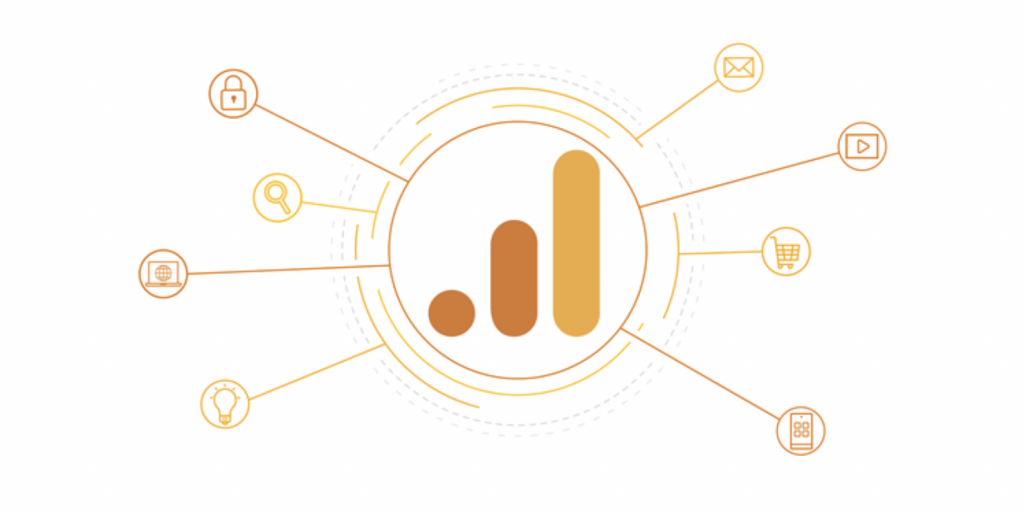Get the lowdown on this new version of Google Analytics.
Here, you’ll find:
- What Google Analytics 4 (GA4) is all about
- New GA4 features
- What this update means for digital marketers
- How to start exploring the new analytics platform today (and why you should)
Are you one of the many digital marketers who feels like they practically live in the Google Analytics platform?
Then you may have been buzzing with anticipation when you heard the search engine giant was rolling out a new and improved version, dubbed Google Analytics 4 (GA4).
Google Analytics 4 is the latest iteration of the popular web analytics tool. Essentially, it’s a hybrid platform of Universal Analytics (UA) and Firebase, Google’s platform for mobile developers.
Announced in October 2020, GA4 promised to usher in smarter insights, cross-platform analytics, a new approach to data control, and much more. Several updates were released during Q1 of 2021 as well.
Machine learning (ML) is at the core of this new tool, providing improved functionality. Below, we take a closer look at what this new GA version is all about, how it can streamline your marketing efforts, and some potential roadblocks you may want to prepare for.

With Google Analytics 4, marketers gain access to more sophisticated data controls to manage and retain information. (Image: Google)
1. Cross-platform analytics
Marketers are already working hard to track user behavior across social media accounts, domains, sessions, and devices. Google Analytics 4 allows you to do it across platforms.
Today, the consumer’s journey happens via websites and apps. GA4 lets you learn how the customer moves across multiple platforms while engaging with your brand.
Let’s say someone browses your website today and then signs up for your services from your app tomorrow. With regular Google Analytics, you could only analyze each stage of this journey separately. Now, you can bring them together to get a clearer picture of how your customers behave.
If this process sounds familiar, that’s because GA4 is a new name for Google’s App+Web property. The former platform was enhanced and adjusted to become Google’s new and improved tool.
With high-quality cross-platform analytics, you can understand which customers’ actions precede the conversion, which can help you better adjust your strategies moving forward.
2. Advanced data control
With Google Analytics 4, marketers gain access to better data controls to manage and retain information. You can choose when to implement customer data into ad optimization or when to limit the data use to pure measurements.
The new data control approach allows marketers to start adapting to the impending cookie-less scenario brought about by changes to online data privacy.
In the future, GA4 will include conversion modeling to help measure the customer’s journey without cookies (trackers that were used to monitor and analyze site visitor behavior) and identifiers.
With advanced data control, you can rely on GA4 to measure marketing results even when third-party cookies are completely phased out.
3. More insights from machine learning
As Google continues to integrate more ML into its analytics tools, marketers are able to see more insights into future customer behavior.
The program analyzes trends in collected data to predict consumer behavior. This is based on things like past purchasing actions, browsing habits, ad-clicking activity, and more.
In the future, when Google adds new predictive metrics, you’ll have the option to predict revenue for certain customer segments as well. These insights can help you analyze different customer groups to understand why some spend more than others, so you can better optimize campaigns.
4. Benefits for Google Ads
Put simply, Google Analytics 4 provides deeper integration with Google Ads.
By using data collected and analyzed by GA4, you can create more specific custom audiences and segments to enhance your paid search marketing efforts.
As a bonus, you can track conversions that came from YouTube with GA4.
Need more help with Google Ads? You’ve come to the right place.
5. New Google Analytics 4 features
Here are a few additional features offered by GA4:
Free BigQuery Integration
The BigQuery integration helps you send raw data directly to the cloud data warehouse to generate ML-driven insights.
Funnel feature
Previously available only on GA360, the funnel feature is now accessible to all GA4 users to build segmented custom funnels.
Event tracking
With GA4, you don’t need to add custom code or use Google Tag Manager for core events. The new tool includes automatic event tracking with an Enhanced Management feature for scroll, outbound clicks, site search, video engagement, page views, and file downloads.
Custom reports
GA4’s Free Form (ex-Analysis Hub, ex-Explorations) option offers access to custom reports. You can create visualizations of cohorts, paths, funnels, or segments to get a better understanding of their behavior. These reports are shareable, printable in PDF format, and downloadable as an Excel workbook.
Custom tables
GA4 allows you to customize automated tables. Users with admin access can customize data presented in the program’s reports, saving you time on juggling metrics and dimensions.
Anomaly detection
This AI-powered tool allows you to identify anomalies in metrics over time. When a value changes drastically (beyond the set interval), you get notified.
Improved audience builder
GA4 improved the existing audience builder feature and added more options, including event scoping, time-based sequences, exclusion, and duration. As a bonus, exclusions aren’t all permanent.
Better debugging
A nice new feature GA4 offers is the debugging view. You can put the test data into one report specifically created for debugging, which improves troubleshooting.
Attribution measurement
You can now (finally) update the attribution measurement within the platform to options like data-driven and position-based.
Time measurement
A huge GA4 benefit is the ability to measure time in a way you couldn’t with UA. GA4 can measure time between actions vs. UA, which could essentially only measure time on site.

While there are some hoops to get through, it seems fair to remain optimistic that the additional features we all want will continue to be built out. (Image: Unsplash)
Potential GA4 drawbacks
Once the initial excitement around GA4 subsided, a few downsides came to light. Even though implementation seems inevitable, not all marketers are amazed by the new tool.
If you’ve been using Universal Analytics for years, GA4 could be hard to get used to. The new program is substantially different. Some issues marketers have pointed out include:
- The need to use separate tools for data collection, analyzing, and reporting
- Some old pre-defined reports (landing page, site search) are gone
- Data organization tiers went from Account-Property-View to Accounts and Property
- There are no GA4 filtering mechanisms for things like updating URLs from uppercase to lowercase
- The fact that you now build data collection off data streams can take some getting used to
- You no longer build out and track goals the same way
- E-commerce tracking is a bit more complicated
- There’s no annotation feature
Despite these snags, many new marketers call GA4 beginner-friendly. It seems to have a lower learning curve for someone who has never used Universal Analytics before, but a steeper one for seasoned GA users.
It’s also worth noting that many of the features that exist now were missing even earlier this year. So, while there are some hoops to get through, it seems fair to remain optimistic that the additional features we all want will continue to be built out.
All the new options make it tougher to find your way around the program, which seems to be a good reason to set it up. That way, by the time Google phases out UA in July 2023, you’ll already be an expert.
Historical Google Analytics data issues
Another problem marketers face with GA4 involves keeping historical data.
When you set up a GA4 account, the program begins collecting data from your website. Everything you’ve collected over previous years doesn’t appear in the GA4 view. That means you can’t currently compare year-to-year data on the same platform.
Thankfully, the data will remain in the UA reports. There’s also an option to run GA4 and UA together to make comparisons. However, using these programs side by side is a bit tedious.
Pro tip: GA4 has a setting that defaults data retention to two months. We recommend a best practice of setting this to 14 months upon implementation.
GA4 beta features
Even though GA4 has been around for a while at this point, many features are still in beta. As a result, some bugs are unavoidable.
While it’s hard to feel this benefit right now, Google promises that the use of AI will keep the new tool evergreen for many years.
The ability of the program to learn continuously should help users adjust to the new rules around the privacy matter beyond the cookie phaseout. The tool should collect enough data to patch the holes made by the internet privacy laws.
The takeaway
Google Analytics 4 is a highly efficient analytics tool with impressive potential for future improvements.
Getting used to GA4 now will help you in the long run as we come to the “end of days” with Universal Analytics.
Not only that, but with Google being one of the leading ad platforms in the world, GA4 is an excellent opportunity to take full advantage of the existing features and improvements available.
By having an expert implement GA4 into your marketing efforts today, you can start preserving historical data ASAP and gain an advantage over competitors who may not yet be on the bandwagon.
This post has been updated and was originally published in December 2020.

